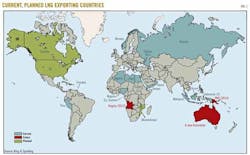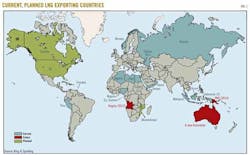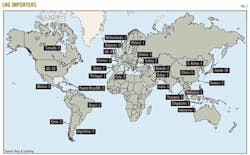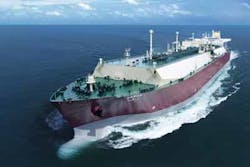Global LNG 2012 and beyond must address many questions
Philip R. Weems
King & Spalding
Singapore
Matt Salo
King & Spalding
Houston
Already witness to a number of changes in recent years, the global LNG industry in 2012 is likely to see further changes as unconventional LNG export projects begin to come on line, new countries begin LNG imports, and new gas discoveries make export projects possible in new regions of the globe.
The rapid developments in unconventional natural gas, especially North American shale gas and Australian coalseam gas (CSG), have changed the LNG playing field. New discoveries off East Africa should propel Mozambique and perhaps Tanzania into the top ranks of the world's LNG exporters.
In addition, the number of countries planning import terminals continues to expand rapidly, whether these be of traditional onshore or the newer floating or offshore type.
For a variety of reasons natural gas gained exceptional acceptance in 2011 as the fuel of choice, with updated predictions now proclaiming it will overtake coal as the world's second largest energy source by 2030…or sooner.
With numerous technological, commercial, and geopolitical factors influencing a global LNG market in flux, the LNG industry will surely grapple with several questions in 2012.
Australian LNG stall?
Although Australia is currently forecast to become the world's largest LNG exporter, surpassing Qatar by 2020, achieving this level of success is no certainty. No country has ever undertaken construction of so many LNG export projects at the same time (Fig. 1).
Australia's unprecedented growth in export capacity may be tempered by a number of factors. Many planned LNG export projects are based on CSG reserves, not previously used to support an export project from a technical standpoint, and the costs surrounding CSG production continue to rise. This includes the cost of labor, which has been driven up by the shortage of experienced labor.
For example, Woodside Petroleum announced in December it was postponing a final investment decision on its Western Australian Browse LNG project due in part to concerns about escalating costs.
Although the Queensland-based Australia-Pacific LNG project secured a commitment to a long-term sale with China Petroleum & Chemicals Corp. (Sinopec) in late 2011 that should enable taking an FID on the project's second train, the "cost" to the project sponsors of such expansion will be the sale of additional project equity to Sinopec.
While other current export projects in Queensland have shown a desire to expand, the recent buyer hesitation to commit to long-term deals, as well as gas deliverability and limitations on the funding required for expansion, appear to make expansion difficult for these projects at present.
The Australian government has also recently mandated increased environmental scrutiny of CSG projects and passed a carbon tax that will worsen the economics of operating LNG export plants. When coupled with the fact that the sales prices obtained to date for CSG-based LNG have not been high by historical standards, these factors indicate Australia's unprecedented expansion may start to slow.
Despite the recently announced FID for the Ichthys project, few more are likely in Australia in 2012, and the ability of Australia to see additional FIDs in coming years will likely depend on whether proposed projects can compete globally on the basis of cost and dependability.
Offshore East Africa: new LNG frontier?
Although the coming years may see large export projects gain steam in such places as Israel or Cyprus, major new gas discoveries off East Africa may make it the most promising LNG frontier.
This region could also become a major competitor of Australia and other exporting countries, as both Mozambique and Tanzania look to join the ranks of the world's LNG exporting nations. Massive conventional gas reserves discovered by Anadarko in 2010-11 in the Rovuma basin are expected to prove LNG exports in the region are commercially feasible (OGJ Online, Nov. 29, 2010; Nov. 29, 2011).
East Africa is well positioned to serve the Asian market and, like Qatar, European customers as well.
More floating liquefaction?
After spending more than $1 billion in development costs, Shell announced in 2011 its FID on the Prelude floating liquefaction project, which promises to be the largest floating structure ever built (OGJ Online, June 27, 2011).
Floating-liquefaction technology has been viewed as attractive because it allows producers to bring liquefaction directly to the source of offshore natural gas, but such projects are extremely costly. And while floating liquefaction is well suited for the benign waters off Western Australia, its suitability using current technology in rough seas is problematic. Moreover, lenders and buyers may question its use in developing countries' waters, which they perceive as susceptible to marine terrorism.
On a positive note, South Korean shipyards have shown a high level of interest in building these vessels, and these shipyards could offer attractive pricing that helps make floating liquefaction more economically competitive.
Notwithstanding the foregoing and the efforts of such companies as FLEX LNG, which is actively pursuing floating-liquefaction technology, additional FIDs in 2012 for floating liquefaction will depend on another location suitable for this niche technology being found.
North American LNG exports?
A few years ago, LNG import terminals were constructed across North America in response to a dwindling domestic natural gas supply. Now, with the rise of unconventional gas production in North America, many of these terminals are trying to convert to export terminals, including the Sabine Pass and Freeport LNG terminals on the US Gulf Coast.
In fact, Sabine Pass Liquefaction has recently entered into three LNG sale agreements for exports from its Cameron Parish, La., terminal (OGJ Online, Dec. 12, 2011). In Canada, the various LNG export projects in British Columbia (led by frontrunner Kitimat LNG being developed by Apache, EOG, and Encana) seem well positioned—geographically and otherwise—to access the lucrative Asian market (and the accompanying oil-based sales prices). And they may benefit from a more favorable political climate for such projects than exists in the US. Whether Canadian LNG exports will attract LNG buyers and justify FID in 2012 remains to be seen, however.
While there certainly seems to be demand for Gulf of Mexico exports, the question of who will fund construction of such liquefaction and how funding will be structured (by project finance or equity, or both) remains unanswered. It is also unclear whether any of the planned US green-field projects (in Oregon or elsewhere) will begin to gain steam despite the competitive advantage held by the existing import terminals already interconnected with natural gas transportation infrastructure.
New LNG importers?
The past couple of years have seen several countries (including the Netherlands, Argentina, Brazil, Kuwait, Thailand, and the UAE) join the ranks of LNG importers. The coming year will see the number of countries choosing to import LNG continue grow as natural gas rises in importance as a source of energy (Fig. 2).
This trend could affect the suspended import terminal in Germany in the wake of Japan's Fukushima Daiichi nuclear disaster, which prompted Germany's decision to phase out nuclear power. Natural gas has become the main replacement fuel for nuclear in places that have stopped or delayed nuclear projects due to safety concerns.
Countries currently constructing import terminals include Singapore, Malaysia, Poland, and Indonesia.
Once the world's largest LNG exporter, Indonesia recently approved plans to begin importing LNG needed to meet rising domestic industrial demand. Malaysia, the world's second largest LNG exporter, plans to receive its first LNG imports in 2013 (OGJ, Aug. 8, 2011, p. 14).
Vietnam is currently developing plans to construct import capacity, and other potential LNG importers in the coming years include Pakistan, El Salvador, Uruguay, South Africa, Bahrain, Croatia, the Philippines, Abu Dhabi, Jamaica, and perhaps Israel. Some of these potential importers may be looking to enter LNG supply agreements in 2012.
Regulatory risks of unconventional LNG?
The perceived negative impacts of the technologies used to exploit CSG and shale gas, especially with respect to water, have put these technologies at risk of severe government regulation. For example, although France has significant shale gas reserves, its government has banned the use of hydraulic fracturing for commercial purposes.
2011 saw a number of protests against developments of CSG in Australia and shale gas in the US, Canada, and elsewhere, and these protests will likely continue. The Australian government announced late last year plans to increase environmental scrutiny of new CSG projects in response to public concern.1
The US government has yet to take action restricting hydraulic fracturing (which is currently viewed as necessary to economically exploit shale gas reserves), but a recent draft report released by the US Environmental Protection Agency may spark increased federal regulation of the practice. The draft report links hydraulic fracturing to contamination found in groundwater in Wyoming.2
Some individual US states have placed restrictions on hydraulic fracturing due to environmental concerns. For example, New Jersey has banned the practice, at least temporarily (OGJ Online, Aug. 25, 2011). Environmentalists and other opposition groups are likely to continue to lobby for such bans in other states in 2012.
Project financing?
To date, Queensland's multiple CSG-based LNG export projects have been balance-sheet financed. The project sponsors have sold a substantial part of the projects to the buyers of the LNG (primarily based in China, Malaysia, and South Korea).
So far, banks have been reluctant to provide project financing to CSG-based LNG projects. Because CSG technology has not yet supported an LNG export plant, banks have been unwilling to assume the perceived technical risk in a project financing. Banks continue to finance conventional gas-to-LNG export projects in such developing countries as Papua New Guinea but have yet to provide project financing to an Australian CSG-based project.
And questions surrounding project financing are not limited to unconventional LNG projects in Australia. Project financing has yet to occur in support of planned US Gulf Coast LNG exports, but we may soon know whether project finance will support such an endeavor as Cheniere's Sabine Pass Liquefaction project, which recently signed of three LNG sale agreements and an engineering, procurement, and construction agreement to design and construct its export plant (OGJ Online, Nov. 16, 2011; Dec. 12, 2011).
Effect of new contracts, sources?
Many LNG sales-and-purchase agreements today contain price-review provisions intended to utilize current Asian LNG import pricing as the basis for resetting future LNG sales prices. As sales-and-purchase agreements for North American LNG are entered into in 2012 and the East African export projects gather steam, the impact of these new sales on LNG pricing will begin to appear.
To date, Australian projects have been able to sell their LNG for a Japan Crude Cocktail price indexed to oil, although at lesser pricing curves than the market highs of 2008-09.
Although each of the North American export projects would like to follow suit and sell at JCC-based prices for Asian cargoes, North American gas prices are based on the Henry Hub index and potential Asian buyers may either try to negotiate an LNG sales price that is delinked from oil or at least push for a lower indexed price due to the perceived market effects of North American priced gas.
Notably, pricing for Sabine Pass Liquefaction's LNG sales contracts are based on Henry Hub pricing, although the approach taken in such contracts is more akin to a tolling arrangement than to a traditional LNG sale.
LNG as transport fuel?
LNG has been touted as the shipping transportation fuel of the future, and some reports have stated it may mount a challenge to oil's stranglehold in this area. Because it's cleaner burning than other options, a switch to LNG may help some countries and ports meet emission-reduction targets.
But will LNG catch on as a transport fuel, especially given the shortage of LNG distribution infrastructure at relevant ports globally? While 2012 should see an increase in newbuild orders for non-LNG ships that are LNG fueled, unless and until a clear set of economic and political drivers arise to push for transformation, it seems unlikely that the technical changes needed to make the switch to LNG as the shipping transport fuel of choice will happen extensively in the short term.
HNS to come into force?
The International Maritime Organization's International Convention on Liability and Compensation for Damage in Connection with the Carriage of Hazardous and Noxious Substances by Sea, 2010, is an international treaty providing more than $600 million in compensation to victims of a casualty involving the carriage by sea of hazardous and noxious substances ("HNS").
LNG is included within the convention's definition of HNS. And as such, the convention will directly impact LNG shipments into countries adopting it.
For the first time, an international liability regime is expected to make LNG shipowners and LNG receivers or cargo owners strictly liable for accidents solely as a consequence of LNG being classified as HNS, thereby increasing the potential liability of shipowners and importers for damages to third parties in any state that is a party to the convention.
Originally adopted by a conference organized by the International Maritime Organization in 1996, the convention was amended in 2010 to address some of the issues that kept the original version from being ratified. Under its current provisions, a receiver of LNG is liable for certain costs and damages unless the relevant sales-and-purchase agreement provides otherwise.
The convention requires the signature of 12 countries in order to come into force (among other requirements); a total of 8 states have signed (subject to ratification) since April 2011. These states are Canada, Denmark, France, Germany, Greece, the Netherlands, Norway, and Turkey. Other states are expected to follow suit in 2012.
With the LNG world containing a number of new participants and the number of LNG carriers rising, the question remains as to whether the industry is prepared for the potential strict liability imposed by the convention.
As a result, LNG buyers and sellers that are at present negotiating contracts would be well advised to think about ways in which the convention's implementation might affect their respective business models.
References
1. The Australian, Dec. 1, 2011.
2. "Investigation of Ground Water Contamination near Pavillion, Wyoming," draft 2011, US Environmental Protection Agency (http://www.epa.gov/region8/superfund/wy/pavillion/.Show citation box).
The authors
More Oil & Gas Journal Current Issue Articles
More Oil & Gas Journal Archives Issue Articles
View Oil and Gas Articles on PennEnergy.com





